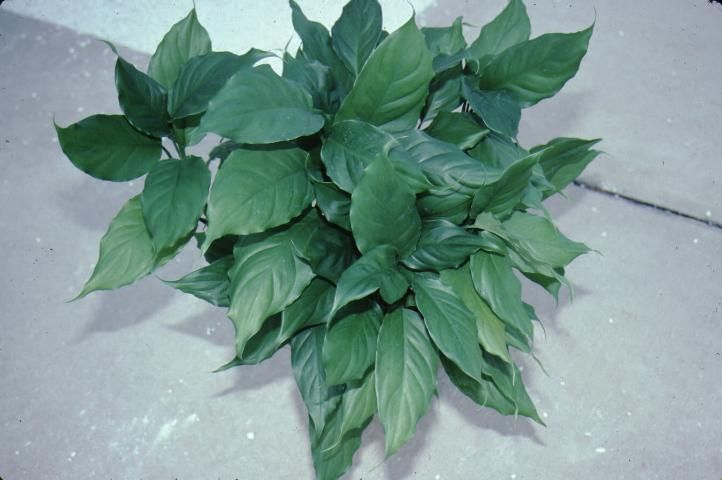Aglaonema modestum: Chinese Evergreen
Introduction
Easily grown, the attractive plants eventually form substantial clumps of green stems with 10- to 14-inch-long, shiny, deep green leaves. This lends a tropical characteristic to any shaded area planted with Chinese evergreen. The plant requires shade, making it well-suited to low-light conditions for house plants or sheltered, outdoor northern exposures. Temperatures below 45°F can injure the foliage.


Credit: Edward F. Gilman, UF/IFAS
General Information
Scientific name: Aglaonema modestum
Pronunciation: ag-lay-o-NEE-muh mo-DESS-tum
Common name(s): Chinese evergreen
Family: Araceae
Plant type: perennial; herbaceous
USDA hardiness zones: 10B through 11 (Figure 3)
Planting month for zone 10 and 11: year-round
Origin: not native to North America
Invasive potential: not known to be invasive
Uses: mass planting; container or above-ground planter; groundcover; suitable for growing indoors
Availability: generally available in many areas within its hardiness range

Description
Height: 1 to 3 feet
Spread: 2 to 4 feet
Plant habit: upright
Plant density: moderate
Growth rate: slow
Texture: medium
Foliage
Leaf arrangement: spiral
Leaf type: simple
Leaf margin: undulate
Leaf shape: ovate
Leaf venation: pinnate
Leaf type and persistence: evergreen
Leaf blade length: 8 to 12 inches
Leaf color: green
Fall color: no fall color change
Fall characteristic: not showy
Flower
Flower color: green
Flower characteristic: summer-flowering
Fruit
Fruit shape: oval
Fruit length: 1 to 3 inches
Fruit cover: fleshy
Fruit color: red
Fruit characteristic: showy
Trunk and Branches
Trunk/bark/branches: typically multi-trunked or clumping stems
Current year stem/twig color: green
Current year stem/twig thickness: very thick
Culture
Light requirement: plant grows in the shade
Soil tolerances: clay; sand; acidic; loam
Drought tolerance:
Soil salt tolerance: poor
Plant spacing: 24 to 36 inches
Other
Roots: usually not a problem
Winter interest: no special winter interest
Outstanding plant: not particularly outstanding
Pest resistance: long-term health usually not affected by pests
Use and Management
Any fertile, nematode-free soil or artificial media is suitable for growth, yet aglaonemas will survive in peat and perlite, in sand, or can be grown hydroponically. They enjoy moist soil which is allowed to dry slightly before watering. Be careful not to overwater but do not let the soil dry for more than a few days. Aglaonemas require shade since direct sun will turn leaves yellow. They perform admirably in conditions too dark for most other tropical plants. They will succeed in low light, either as house plants or in sheltered locations on the north side of buildings, or under heavy shade of trees. They are attractive planted as single specimens, or in mass to create a tropical, coarse-textured effect. Space plants on 2- to 3-foot centers. Temperatures below 45°F can injure the foliage. Overwatering causes root rot and yellowing of the leaves.
Propagation is by cuttings.
Soil-borne nematodes and mites can be a problem for Chinese evergreen.
Design Considerations
The broad, deep green leaves and lush, leafy, irregular form of the Chinese evergreen will give the landscape a cool tropical feel. The mass of leaves with pointed tips and rippled edges creates a coarse texture and the light and dark shadows within the cluster of leaves emphasize the coarse texture. Pair with plants that are softer with small foliage and mounding or spreading forms, or grasses with thin, strappy blades and wispy flowers. Yellow-green, variegated green, and/or burgundy foliage in the companion plants will highlight the deep green of the leaves. When pairing with other flowering plants use white and/or warm colors such as pinks, light corals, soft yellows, and light orange to contrast the deep green.
Pests and Diseases
No pests or diseases are of major concern. Roots can rot if the soil is kept too wet.


